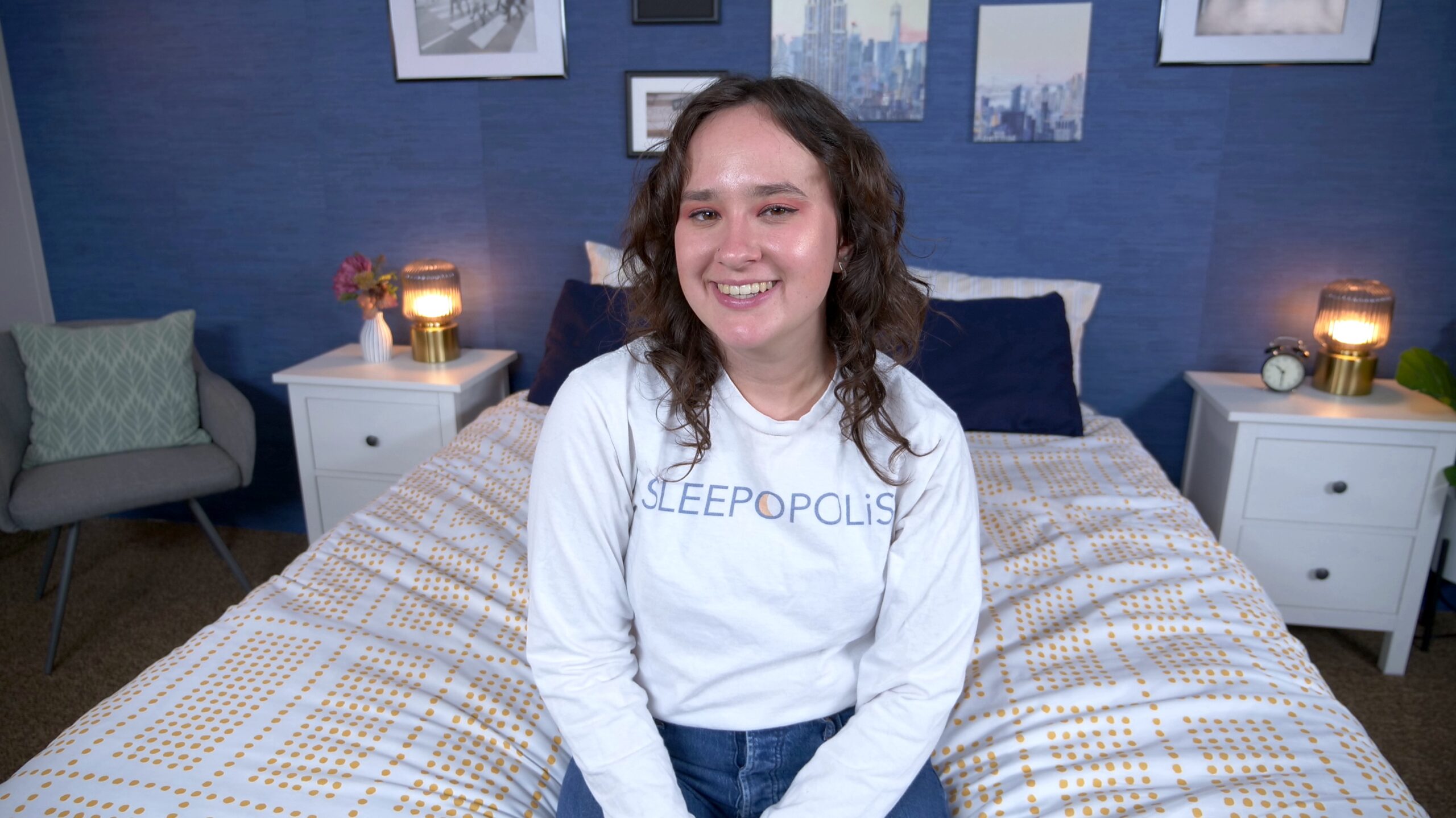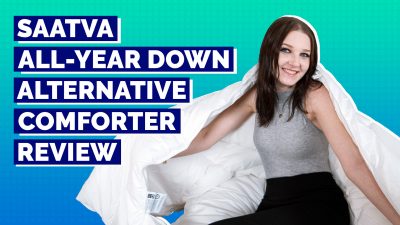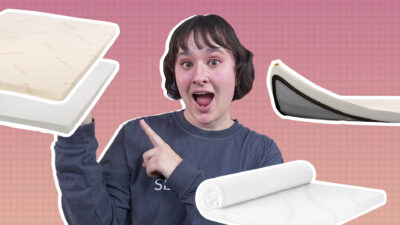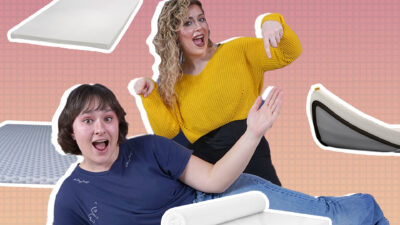If your current mattress just isn’t cutting it, a mattress topper can be an easy solution to bring you new found comfort. The mattress topper I’ll be covering in this review is from Saatva, the brand behind the Saatva Classic innerspring mattress.
It’s a memory foam topper infused with graphite with a super luxurious feel, but is it the right topper for you? Keep reading to find out, or you can always skip to the end for my review summary.
Saatva Graphite Mattress Topper
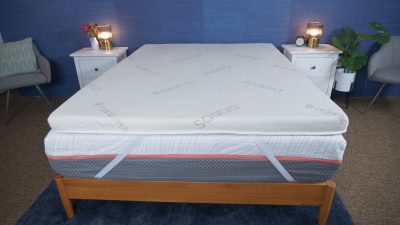
This high-quality topper is made with an organic cotton cover, graphite-infused memory foam, and elastic straps.
Sleepopolis Score
4.80 / 5





Read Full Review
Video Review: Saatva Graphite Mattress Topper

Who is the Saatva Graphite Mattress Topper Best For?
Before you make your final decision about which topper is right for you, you’ll want to consider your budget, your sleeping position, your body type, and whether you sleep hot. If the Saatva isn’t the right match for you, check out all my top picks in our best mattress topper roundup.

Who I recommend the Saatva Graphite mattress topper for
- Hot sleepers should appreciate the Saatva mattress topper’s breathable cotton cover and cooling graphite infusions, which draw heat away from the body.
- Back sleepers should be comfortable on the Saatva topper, as the dense foam allows for pressure relief around the shoulders and lower back.
- Some side sleepers should find the Saatva topper comfortable, providing relief around key pressure points, like the shoulders and hips.
Who I don’t recommend the Saatva Graphite mattress topper for
- Stomach sleepers will likely find the Saatva topper to be too soft. Stomach sleepers need a firm sleep surface to prevent their hips from sinking into the bed, which can cause lower back pain over time.
- Shoppers looking for an easy-to-clean topper might not want to pick the Saatva topper, as its cover isn’t removable.
- Budget shoppers might also consider another topper, as the Saatva mattress topper is definitely a luxury product, so it comes at a luxury price. However, the topper does have a lengthy trial period and we have some Saatva coupons to help you save.
What is the Saatva Graphite Mattress Topper Made Of?
Cover: The Saatva topper’s cover is made with organic cotton, a soft and breathable material that allows for airflow. The cover has anchor bands, which are elastic straps in each corner to secure the topper to your mattress.
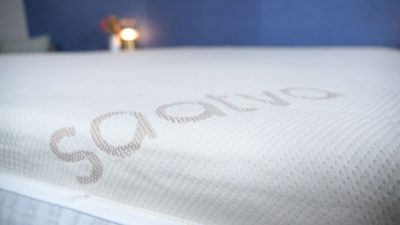
Fill: The fill of the topper is three inches of graphite-infused memory foam. The graphite helps to draw heat away from the body, as memory foam naturally traps heat.
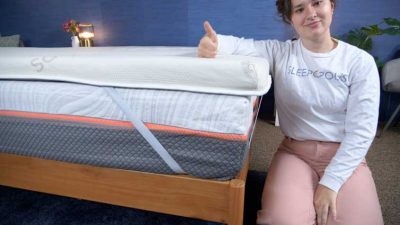
Saatva sells two other variations of mattress toppers, as well. One is filled with traditional memory foam (no graphite infusion) and the other with natural latex.
Additionally, the Saatva mattress topper is available in eight sizes: twin, twin XL, full, queen, king, California king, and split king.
Saatva Graphite Mattress Topper

This high-quality topper is made with an organic cotton cover, graphite-infused memory foam, and elastic straps.
Sleepopolis Score
4.80 / 5





Read Full Review
How Does the Saatva Graphite Mattress Topper Feel?
I personally tested the Saatva mattress topper by laying on it in different sleeping positions, as well as trying it on different mattresses.
I found the Saatva mattress topper really comfortable. The foam feels thick and high-density, so you have a lot of room to sink in for body contouring and pressure relief, while still getting support. The cover is soft and I thought the topper maintained a nice, temperature-neutral feel.
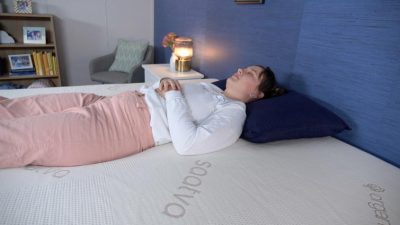
Mattress toppers can alter the feel of your existing mattress, so I tested the Saatva topper with three mattresses of different firmnesses to see how it would change each one.
Soft: Adding the Saatva mattress topper to a soft mattress made for an ultra-soft, squishy feel. I found the bed to be too soft, but it could work for some side sleepers who need deep pressure relief. If you have a soft memory foam mattress, adding this memory foam mattress topper makes for a marshmallowy experience.
Medium-firm: I thought adding the Saatva topper to a medium-firm mattress worked well to make it feel a little more comfy and cozy. The topper provided a lot of cushioning and conformed around me more than the mattress alone, but I still felt supported. It changed the firmness to a true medium, instead of medium-firm.
Firm: Similar to the medium-firm bed, putting the Saatva mattress topper on a firm mattress offered more pressure relief as the foam contoured around me. With the firm bed below, I would say the topper made it feel more medium-firm.
Saatva Graphite Mattress Topper Sizes and Prices
Curious how much this topper will cost? Here’s a breakdown of the prices by size. Prices listed will be before discount or offer for each size.
Use our Saatva coupon to get the best price!
| Size | Dimensions | Price |
|---|---|---|
| Twin | 38″ x 75″ | $245 |
| Twin XL | 38″ x 80″ | $255 |
| Full | 54″ x 75″ | $315 |
| Queen | 60″ x 80″ | $345 |
| King | 76″ x 80″ | $445 |
| California King | 72″ x 84″ | $445 |
| Split King | 38″ x 80″ (x2) | $510 |
Saatva Graphite Mattress Topper

This high-quality topper is made with an organic cotton cover, graphite-infused memory foam, and elastic straps.
Sleepopolis Score
4.80 / 5





Read Full Review
My Verdict on the Saatva Graphite Mattress Topper
The Saatva Graphite mattress topper is a comfortable topper that will work well to help back and side sleepers get more cushioning and pressure point relief on their beds. The thick and high-density foam provides an excellent mix of pressure relief and support.
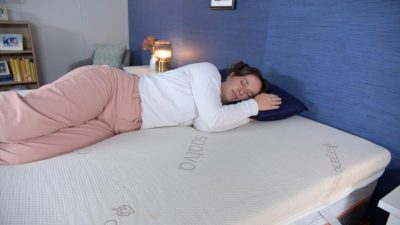
I like the organic cotton cover, which is not only soft and natural, but allows for airflow. The graphite infusions in the memory foam disperse body heat to prevent you from overheating, making it a great option for hot sleepers.
Another favorite feature of mine is the elastic straps, which secure the topper nicely to the mattress. Combination sleepers, who might toss and turn in the night, don’t need to worry about their topper shifting around on the surface of the bed.
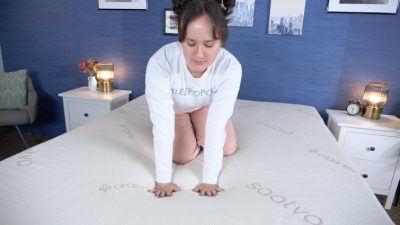
However, I do not recommend the Saatva Graphite topper to stomach sleepers, as it is too soft to maintain their spinal alignment properly. I wouldn’t recommend it to budget shoppers either, as it is at a higher price point than other foam toppers on the market. The Saatva topper uses high-quality materials, like the breathable organic cotton cover and dense foam, but there are better budget options out there.
Additionally, I wish the cover of this topper was removable and machine washable, as that would make it much easier to keep clean.
Saatva Graphite Mattress Topper Brand Policies and FAQs
Does the Saatva Graphite mattress topper come with a warranty?
Yes, Saatva offers a 1-year warranty with this mattress topper.
Does the Saatva Graphite mattress topper have a trial period?
It does. Saatva offers a lengthy 180-night sleep trial with this topper, meaning you can test it out at home for 180 nights and if you decide you don’t like it, you can return it within that trial period for a full refund. See Saatva’s full return policy for more information.
How does the Saatva Graphite mattress topper ship?
This topper ships rolled up in a box and ships for free within the contiguous United States. Currently, Saatva does not ship to Alaska or Hawaii, but they are able to coordinate with a freight forwarding company if you live in one of these states.
Is the Saatva Graphite mattress topper easy to clean?
The Saatva mattress topper is spot-clean only. Saatva recommends using a mild, organic cleaning solution.
Is the Saatva Graphite mattress topper cooling?
The Saatva mattress topper does a good job of temperature regulation, with graphite infusions and a breathable cover. However, I wouldn’t say it feels cool to the touch. Take a look at our best cooling mattress toppers for more options.
Should I buy a new mattress or a mattress topper?
A mattress topper adds a top layer of comfort to your (presumably uncomfortable) mattress. That makes them a great fix for many people. However, if your current mattress is over 10 years old and is visibility deteriorating, we do recommend buying a new one. A mattress topper can’t solve all the problems of a worn-out mattress.
Is a mattress topper the same as a mattress pad or mattress protector?
No, these are three different mattress accessories. A mattress protector simply acts as a barrier for the mattress. Many are waterproof and hypoallergenic. A mattress topper is used to add cushioning and comfort or to change the feel of the mattress. A mattress pad falls somewhere between these two products, offering some protection and some comfort.
Other Products from Saatva
- Saatva Organic Sateen sheets
- Saatva Latex pillow
- Saatva Classic mattress
- Saatva Modern Foam mattress
- Saatva Latex Hybrid mattress
- Saatva HD mattress
- Saatva Solaire mattress
- Saatva Youth mattress
Finally, here are my star ratings of the Saatva Graphite mattress topper.
-
Materials
-
Comfort
-
Value
-
Cooling
-
Trial
-
Warranty
